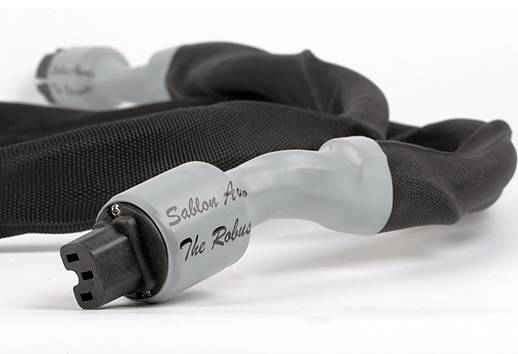 Test
Test
|
Power cable AC Sablon Audio THE ROBUSTO Price: 750 USD/2 m Contact: Sablon Audio Manufacturer: Mark Coles e-mail: contact@sablonaudio.com Manufacturer's webside: Sablon Audio Country of origin: Great Britain Text: Wojciech Pacuła Pictures: Wojciech Pacuła Translation: Marek Dyba |


This is not the first review of this cable even though it's quite unknown brand and in fact one-man-company. Simply the guy behind this product made a lot of effort to rich out to people who could be interested without asking him to buy an ad in their Magazines. The first test of The Robusta was written by Jeff Day for „Positive Feedback Online”, and recently the second one was published on “6moons.com” and written by Paul Candy Now it's my turn. If you compare systems of three of us you will notice some similarities – obviously all of us like brands like Leben and Audio Revive. Is it a reason that got us interested in Sablon Audio cable? Probably not, but surely mailing done by Mark Coles, owner and designer, to all 6moons reviewers helped. I accepted his proposal and a week later I received a parcel with The Robusto inside. 
It doesn't look like much – cotton sleeving with two thick cable runs inside. Each run is thickly insulated with a vibration-absorbing dielectric. Plugs look like Wattgates but I can't tell that for sure but these are surely rhodium/silver-plated. Coles says that his idea was to offer both – fantastic “tube-like” midrange with extended frequency range extremes like from best solid-state devices. According to his idea of perfect sound it should be full, open and transparent with good rhythm and drive. „Musical and analytical, yin and yang, all living together in harmony, with the net result presenting a robust musicality which began its name.” The cord is made from finely stranded soft annealed high purity copper conductors, lots of them in each phase. Mark's testing results reinforced the notion that a large cross-sectional area (CSA) delivered greater transparency, dynamics and solidity. Designer uses equal CSA in both live and neutral phases for best performance with both normal domestic power supplies and also for those enjoying the benefits of balanced power. These conductors are thickly insulated within a vibration absorbing dielectric and are arranged in a unique noise canceling geometry. The cable is earthed for safety, using an external counter-wound earth lead to keep noise away from the music. Mark tested the cable fully shielded, however according to him it dampened the vitality / musicality of the design and was therefore omitted - this cable already has a very low noise-floor on account of its noise canceling geometry. 
Recording used during test:
Japanese issues available at CD Japan. |
Just like Live Cables also The Robusto is a very stiff cable but bit ore flexible which makes it slightly easier to install. Anyway it is a very stiff and heavy cable so you need to be extra careful when installing it in the system – it might just bring down some devices that don't weight too much. Also floating platforms might not be best partners for devices with such PC plugged in. Unlike in most reviews this time I'd like to point out some aspects of Robusto's sound that prove it is not too expensive cable. After that I will show you why it still might be used even in very expensive systems. One very important thing – I compared this cable to my reference one - Acrolink Mexcel 7N-PC9300 which was many times more expensive and that's only why it wasn't so hard to prove that tested PC was not an expensive one. 
Tone that this British cable introduces to the sound it different than the one of Acrolink. Treble in comparison is slightly rounded and there is less information in it. Upper midrange (1-2 kHz) is quite strong, much more distinct than in my cable and it's exactly there where the most information is transferred. Midrange below 1 kHz is not so strongly presented. Another strong part of the range is upper bass. 
As I already mentioned before treble is slightly rolled-off which might make this cable sound a bit dark. I can easily imagine some devices that sound in a very even, well balanced way which makes them … boring? Lifeless? That's where The Robusto should come in – the first tone of Duke’s Mixture from Donald Byrd's The Cat Walk made me jump on my couch – that's how energetic it was. It starts with fast drums play which is a main motive of the whole piece – Coles cable presented it in a great, precise way. There was no compression in the sound.
Also Santana's guitar on Abraxas, in particular in Sea Cabo sounded great – strong, bit harsh, with proper size and volume. The Robusto is quite inexpensive cable considering performance it offers. In my system it was a better match for amplifier than for CD player, although changes it introduced to the sound of both devices were similar. It's a very dynamic, energetic cable which should be appreciated by many potential buyers. It's surely not the most beautiful cable I know but you can't have it all at this price. It should fit in very well to every system that lacks a bit of life or energy – it will light it up and make it sound more attractive for sure. |
||||
g a l l e r y
|
|||||
System odniesienia
|
main page | archive | contact | kts
© 2009 HighFidelity, design by PikselStudio,
projektowanie stron www: Indecity











